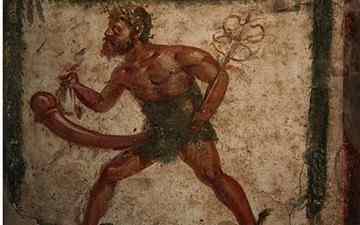For visitors to Pompeii, they are a guaranteed crowd pleaser: erotic frescoes, including one of Priapus, the god of fertility, adorning the walls of a 2,000 year old Roman villa.
 Or rather they were until two years ago, when the House of the Vettii closed for a restoration project which was supposed to last a year but which still grinds on, the villa encased in scaffolding and a sign outside offering no indication of when it might reopen.
Or rather they were until two years ago, when the House of the Vettii closed for a restoration project which was supposed to last a year but which still grinds on, the villa encased in scaffolding and a sign outside offering no indication of when it might reopen.
Pompeii may be the best preserved Roman city in the world, thanks to the volcanic ash from nearby Mt Vesuvius which smothered it after a catastrophic eruption in AD79, but critics say years of neglect and indifference have turned it into an international embarrassment and an emblem of the dysfunction which plagues so much of Italian public life.
Exquisite frescoes are scarred with modern graffiti, weeds are growing out of painted walls and there is a dearth of interpretive signs.
Many of the most famous villas in the city are padlocked behind signs reading "Lavori in corso" – Work in Progress – while the city's most gruesome but irresistible attractions, the plaster casts of ancient Romans who perished in the searing hot ash and pumice emitted by Vesuvius, are displayed in dusty glass cabinets standing on rusted metal legs.
The sense of crisis came to a head last week when the respected broadsheet, Corriere della Sera, ran a front-page editorial under the headline "The humiliation of Pompeii".
"The fact is that this archeological area, which is unique in the world, is unfortunately the symbol of all the sloppiness and inefficiencies of a country that has lost its good sense and has not managed to recover it," the editorial said.
The editorial sparked a political row, with the Italian government of Silvio Berlusconi and the opposition blaming each other for Pompeii's shambolic state.
Nicola Cosentino, a close ally of Mr Berlusconi and a regional coordinator for the governing party, said Pompeii was "like a souk" when the government came into power two years ago.
But Luisa Bossa, an MP with the opposition Democratic Party, said thousands of tourists witnessed the "decay and abandonment" of Pompeii every day. "The site is on its last legs. It is a symbol of the fact that this government cares nothing for Italy's heritage."
Around two million visitors a year pay 11 euros each to visit the site, generating annual revenue of around 20 million euros, but archaeologists say it is not sufficient to fund the unending task of restoring and maintaining the site.
The Berlusconi government has also made deep cuts to arts and heritage funding – the amount of money allotted to the maintenance of ancient sites has dropped from 30 million euros in 2007 to just under 19 million this year.
But Salvatore Settis, a former president of the government's heritage committee, said blame could not be assigned only to the current government. "Parties on both sides have completely marginalised culture and heritage," he said.
Andrew Wallace-Hadrill, a British professor of archaeology who has worked at Pompeii and nearby Herculaneum for more than 20 years, said it was overly simplistic to pin the blame on Italian inefficiency and in-fighting.
"The fundamental reason why there are such enormous problems is the scale and complexity of the site," said Prof Wallace-Hadrill, now the master of Sidney Sussex College at Cambridge University.
The Italian government is believed to be working on the establishment of a foundation which would invite private donors to give money to help preserve Pompeii, possibly in return for advertising opportunities – just as a similar scheme was launched this summer to save the crumbling Colosseum in Rome.
Author: Nick Squires | Source: Telegraph [October 10, 2010]